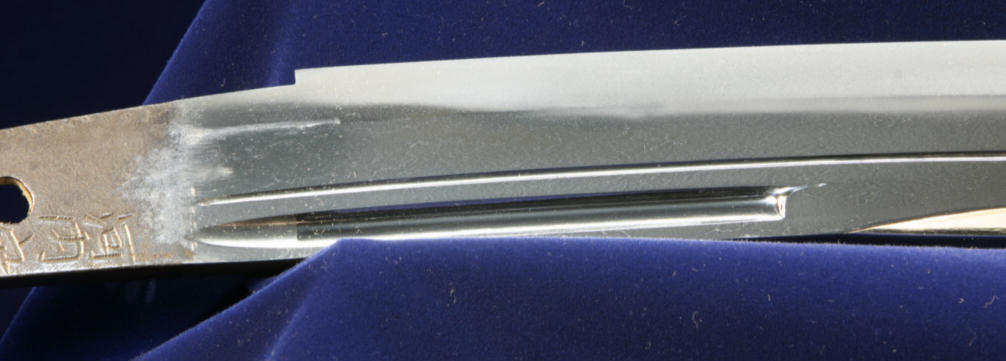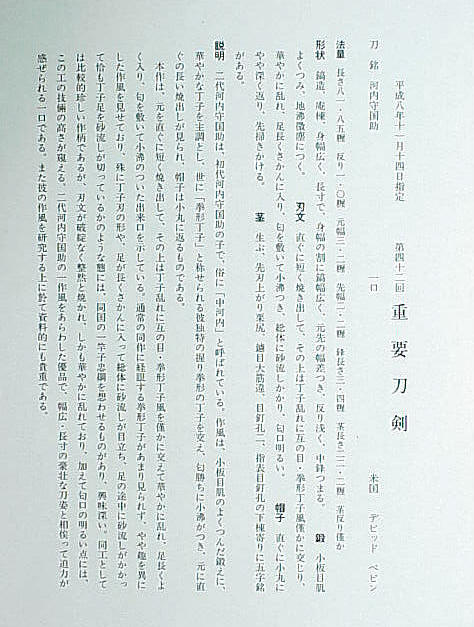Gallery Page (Display Only)
“Shinto Wakizashi” By Kunisuke shodai – 1st Generation
Circa 1624 AD.
Student of Kunihiro
(An Extreme Rarity)
Juyo token by the NBTHK
J?y?-t?ken at the 41st j?y? shinsa held on November 10, 1995
wakizashi, mei: Kawachi no Kami Fujiwara Kunisuke (???????)
T?ky?, Nogoshi Iseko (?????)
Measurements
nagasa 45.0 cm, sori 1.2 cm, motohaba 3.3 cm, nakago-nagasa 13.55 cm, only very little nakago-sori
Description
Keij?: kiriha-zukuri (omote side in unokubi-zukuri style), iori-mune, wide mihaba, sunnobi, thick kasane, deep sori, ?-kissaki
Kitae: rather standing-out itame that is mixed with mokume and that features plenty of ji-nie and much fine chikei
Hamon: ko-notare in nie-deki with a somewhat subdued nioiguchi that begins with a hint of yakidashi and that is mied with gunome, ko-gunome, togariba, ko-ashi, and sunagashi
B?shi: a little bit midare-komi with a ko-maru-style kaeri that is relatively wide on the ura side
Horimono: on the omote side a naginata-hi with soebi, on the ura side gomabashi, on both sides the engravings run as kaki-nagashi into the tang
Nakago: ubu, tang tapers noticeably to a ha-agari kurijiri, ?-sujikai yasurime, two mekugi-ana (of which one is plugged), the sashi-omote side bears towards the back of the tang a naga-mei
Explanation
The first generation Kawachi no Kami Kunisuke (?????) was, like the first generation Izumi no Kami Kunisada (?????, also referred to as Oya-Kunisada), a late student of the Horikawa (??) School. Their early workmanship and signature style suggests that both were de facto trained by their senior fellow student Echigo no Kami Kunitomo (?????). When master Horikawa Kunihiro (????) died, Kunisuke and Kunisada moved from Ky?to to ?saka where they laid the foundation for the ?saka smiths and had a big influence on the later ?saka-Shint? style. It is unclear when Kunisuke received his honorary title Kawachi no Kami, but there exists a naginata and a tant? which are signed with that title and which are dated with the second month of Kan’ei three (??, 1626). No other dated works are known, but there exist blades which are signed with Kawachi no Kami whose interpretation dates them earlier than Kan’ei three. Thus, it is assumed that he received his title around the time the first generation Kunisada received his Izumi no Kami title, which was in Genna nine (??, 1623).
With its omote side being interpreted in an unokubi-zukuri style, this kiriha-zukuri wakizashi is of an uncommon shape, but the wide mihaba, the fact that it is sunnobi, the thick kasane, the noticeable sori, and the ?-kissaki all reflect the characteristic features of a Keich?-Shint?. The kitae is a rather standing-out itame that is mixed with mokume and that displays plenty of ji-nie and fine chikei, thus tending overall to the typical forging structure of the Horikawa School. The hamon is a ko-notare in nie-deki with a somewhat subdued nioiguchi that begins with a hint of yakidashi and that is mied with gunome, ko-gunome, togariba, ko-ashi, and sunagashi. This hamon differs from the hardening commonly seen on works of Kunisuke as it shows Mino characteristics and bears resemblance to the style of Echigo no Kami Kunitomo, underlining so the above mentioned tradition that Kunisuke was de facto trained by Kunitomo. We have here a masterwork that displays one of the known workmanships of Kunisuke whose stout shape is certainly a plus factor.
Another example of a Juyo Kunisuke – from the collection of David E J Pepin
J?y?-t?ken at the 42nd j?y? shinsa held on November 14, 1996
katana, mei: Kawachi no Kami Kunisuke (?????)
USA, David Pepin
Measurements
nagasa 81.85 cm, sori 1.0 cm, motohaba 3.2 cm, sakihaba 2.2 cm, kissaki-nagasa 3.4 cm, nakago-nagasa 22.2 cm, only very little nakago-sori
Description
Keij?: shinogi-zukuri, iori-mune, wide mihaba, long nagasa, the shinogi-ji is in relation to the mihaba wide, noticeable taper, shallow sori, compact ch?-kissaki
Kitae: very dense ko-itame that features ji-nie
Hamon: flamboyant ch?ji-midare that starts with a short yakidashi and that is mixed with gunome, a hint of kobushigata-style ch?ji, many long ashi, and sunagashi all over the blade, the nioiguchi is wide and embedded ko-nie
B?shi: sugu with a relatively wide ko-maru-kaeri and with hakikake at the tip
Nakago: ubu, ha-agari kurijiri, ?-sujikai yasurime, two mekugi-ana, the sashi-omote side bears below of the first mekugi-ana and towards the back of the tang a five-character signature
Explanation
The second generation Kawachi no Kami Kunisuke was the son of the first generation Kawachi no Kami Kunisuke and is referred to as “Naka-Kawachi” (???). His workmanship features a kitae in a dense ko-itame and a flamboyant ch?ji-based hamon that is mixed with a unique fist-shaped ch?ji that is referred to as kobushigata-ch?ji. His ha is hardened in nioi-deki with ko-nie, has a long sugu-yakidashi, and the b?shi ends in a ko-maru-kaeri.
The second generation Kawachi no Kami Kunisuke was the son of the first generation Kawachi no Kami Kunisuke and is referred to as “Naka-Kawachi” (???). His workmanship features a kitae in a dense ko-itame and a flamboyant ch?ji-based hamon that is mixed with a unique fist-shaped ch?ji that is referred to as kobushigata-ch?ji. His ha is hardened in nioi-deki with ko-nie, has a long sugu-yakidashi, and the b?shi ends in a ko-maru-kaeri.
This Sword is not available for purchase.
If you wish to purchase a Japanese Sword, please view our Nihonto for sale page or contact us directly via email or by telephone at 1(608) 315-0083 any time. Please include specifics of what you seek, i.e.: Katana, maker, era, price range, etc.
Pictures and content may not be copied without the express permission of samuraisword.com ©















